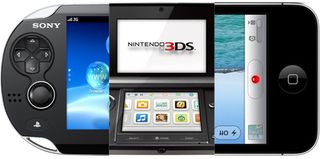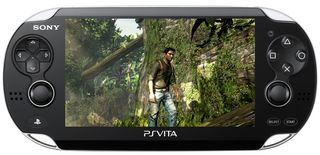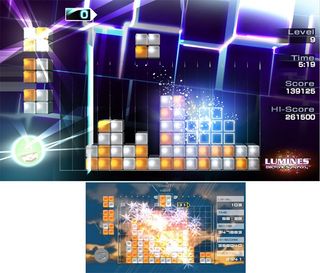The PlayStation Vita hardware is a modern mash-up of fresh ideas and familiar elements already seen on the console or handheld sides of the gaming world. But if you haven't had a chance to hold Sony's new portable in your hands, it might be difficult to imagine how a list of technical specs translates into immersive play experiences, and how the system compares to what's already out there.

Above: How does Vita stack up against the 3DS, iPhone and PSP? Let's break it down by specific features
Rather than inundate you with a catalog of message-board-flame-war-ready numbers and stats, we decided to break down some of the Vita's key hardware specifications and look at how they impact the average player's use of the machine, as well as compare them to the primary existing handheld competition.
The display
Vita has: Five-inch OLED screen – 960x544 pixels (qHD) @ 220 ppi

The Vita's big, bright touchscreen offers crisp, colorful visuals that are a far sight better than Sony's earlier PSP. At 960x544 pixels, the Vita display is considered a qHD, or "quarter HD" screen, since its screen has one-quarter the pixels of a full 1080p display at a 16:9 aspect ratio. The "ppi" spec refers to "pixels per inch," which has become a popular way to describe how crisp a screen looks in the wake of Apple's iPhone 4 and 4S Retina displays putting up a remarkable 326 ppi. More pixels per inch means less pixelization or fuzziness, and more cleanly rendered text and visuals.
Comparatively, the Vita display weighs in at just 220 ppi (though we've seen some Android displays with higher ppi stats put up slightly more pixelated-looking text and images than what we've witnessed thus far on the Vita). Either way, the Vita is still notably sharper than the last-gen PSP, the standard model of which boasted a 4.3-inch display running at 480x272 for a ppi of 128, while the smaller PSPgo screen, at the same resolution, squeezed 145 ppi into a 3.8-inch display.

Above: To compare those resolutions directly, here's a screen from Lumines: Electronic Symphony for Vita at top (scaled down from 960px to 620px to fit our column width), with a screen from the PSP Lumines at bottom (scaled from 480 px to 310 px to maintain size ratio)
Directly comparing the Vita and Nintendo 3DS screens is a trickier proposition. The 3.53-inch top screen of the Nintendo 3DS runs at 800x240 for a listed ppi of 237, purportedly topping the Vita in 2D. However, with the 3D effect, the screen splits that resolution between each eye, effectively becoming a 400x240 image (132 ppi) for each. Meanwhile, the lower screen runs at a rather paltry 320x240 pixels across 3.02 inches, for a 2D ppi of 132 that matches the top screen's 3D number. But we don't have to tell 3DS owners that the bottom screen is a fuzzy, dated little thing.
Graphics/processor
Vita has: Quad-core ARM Cortex-A9 MPCore processor w/ quad-core SGX543MP4+ GPU; 512MB RAM with 128MB VRAM

Above: Uncharted: Golden Abyss is one of the Vita's more visually impressive launch titles
The PlayStation Vita pumps out the most impressive visuals we've seen to date on a handheld, with characters, environments, and effects that nearly approach the levels of early PlayStation 3 titles – and it's sure to improve over the coming years. The handheld's quad-core processor reportedly runs at upwards of 1.5Ghz, compared to the 1Ghz dual-core A5 processor seen in the iPhone 4S and iPad 2. Similarly, the Vita, iPhone 4S and iPad 2 all utilize similar PowerVR GPUs (graphics processing units), though the Vita's is a quad-core, while Apple's devices run dual-cores.

Above: Meanwhile, Infinity Blade II is generally seen as the high-water mark for iOS visuals
Additional processing cores and a higher overall processing speed mean much more processing muscle to handle detailed visuals at higher frame rates. Both the iPhone 4S and Vita have 512MB of core system RAM, while the Vita adds an extra 128MB of VRAM specifically for the graphics. In total, the Vita has more total RAM available than the PlayStation 3, which offers 256MB each for both general RAM and VRAM. The additional RAM helps explain why the Vita offers cross-game chat, while the feature remains MIA on PS3.
Lining up official specs for the 3DS proved mostly fruitless, as Nintendo's handheld uses a proprietary processor along with a single-core PICA200 GPU, plus 128MB of system RAM. Meanwhile, the PSP utilizes a pair of 333 Mhz processors along with a 166Mhz GPU, which utilizes just 2MB of VRAM alongside a paltry 32MB of system RAM and an extra 4MB of dynamic RAM.
Next page: Controls, battery, storage and more
